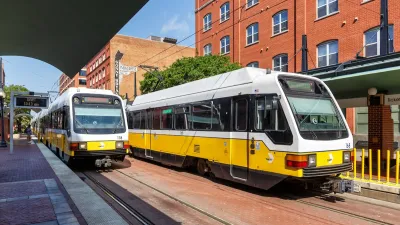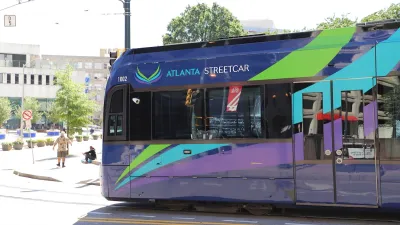Governing Magazine takes a look at the light rail explosion in the Southwest, particularly in Phoenix, where weather is a major factor in ridership.
"Hey! What do you know? It's cold!"
Rick Simonetta isn't talking about the temperature in downtown Phoenix, which today is 92 degrees in the shade. What's cold is the water he's sipping from a fountain on the platform of an outdoor train station. Right now, the platform is eerily devoid of passengers, its modern, sage-colored ironwork glinting in the Southwestern sun. But come December, when Phoenix opens its first light-rail line, this station will anchor a huge regional transit system that will stretch north to Glendale and east to Mesa and Tempe. It's a $1.4 billion, 20-mile catapult into transit - no other light-rail system in the country has been so large right from its inception.
As Simonetta, the system's CEO, inspects the gleaming new stations, he's focused on the details. Phoenix, he notes excitedly, will boast - make that boasts already - the first light-rail stations anywhere with chilled water fountains. Simonetta figures that will be a necessity if he's going to persuade drivers to get out of their air-conditioned cars and stand in the heat waiting for trains. To that end, other touches at the stations include sweeping sail-shaped sun shades, tilted in a way that keeps at least 40 percent of the platform shaded at all times, and sand-colored concrete that deflects heat rather than absorbs it. Simonetta can easily envision this station teeming with commuters headed to work, college students on their way to class and other residents coming downtown to shop, catch a concert or watch basketball's Suns or baseball's Diamondbacks play."
FULL STORY: Leaping into Light Rail

Alabama: Trump Terminates Settlements for Black Communities Harmed By Raw Sewage
Trump deemed the landmark civil rights agreement “illegal DEI and environmental justice policy.”

Planetizen Federal Action Tracker
A weekly monitor of how Trump’s orders and actions are impacting planners and planning in America.

The 120 Year Old Tiny Home Villages That Sheltered San Francisco’s Earthquake Refugees
More than a century ago, San Francisco mobilized to house thousands of residents displaced by the 1906 earthquake. Could their strategy offer a model for the present?

Ken Jennings Launches Transit Web Series
The Jeopardy champ wants you to ride public transit.

BLM To Rescind Public Lands Rule
The change will downgrade conservation, once again putting federal land at risk for mining and other extractive uses.

Indy Neighborhood Group Builds Temporary Multi-Use Path
Community members, aided in part by funding from the city, repurposed a vehicle lane to create a protected bike and pedestrian path for the summer season.
Urban Design for Planners 1: Software Tools
This six-course series explores essential urban design concepts using open source software and equips planners with the tools they need to participate fully in the urban design process.
Planning for Universal Design
Learn the tools for implementing Universal Design in planning regulations.
Clanton & Associates, Inc.
Jessamine County Fiscal Court
Institute for Housing and Urban Development Studies (IHS)
City of Grandview
Harvard GSD Executive Education
Toledo-Lucas County Plan Commissions
Salt Lake City
NYU Wagner Graduate School of Public Service





























